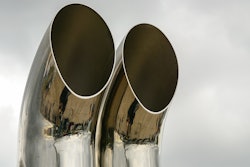For older engines and off-road engines that still will be running on high-sulfur fuel, drain intervals may need to be adjusted.
Editor’s note: This is the fourth in a series of articles on what to expect from 2007/2010 engines, in terms of maintenance, durability, fuel economy and overall cost.
They may not look any different from today’s CI-4 oils, but CJ-4 engine oils will have better resistance to thermal breakdown; less total alkalinity, or TBN; better detergency and dispersancy; and less traditional additives like phosphorous and sulfur. Here’s why:
Taking the heat
For starters, ’07 engines will use higher levels of cooled exhaust-gas recirculation (EGR) to cool peak cylinder temperatures and further reduce oxides of nitrogen (NOx) emissions. Even Caterpillar, which so far has relied on its Advanced Combustion Emissions Reduction Technology (ACERT), will use some EGR – although, unlike other systems, exhaust gas will be drawn aft of a particulate filter. More on filters later.
To cool exhaust gas prior to introducing it into the engine’s intake, a heat exchanger is used. Engine coolant, which is relatively cool compared to exhaust gas, is used in the exchanger to pull heat out. And with more EGR – up to 35 percent – the coolant will have to absorb more heat. And, in getting rid of that heat, “we’re limited by the frontal area of the truck,” says Steve Goodier, BP/Castrol’s technical manager, Americas. “In fact, since many transmissions use oil coolers, transmission lube also can be affected.”
Bottom line: ’07 engines will run hotter and will require an oil with improved oxidation resistance to prevent thermal breakdown and attendant loss of engine protection. “There will be more thermal stress on engine oils,” says Reginald Dias, director of commercial products for ConocoPhillips Lubricants. “We need to use nontraditional, high-performance additives, since thermal stability comes from the complete package – base stock and additives.”
“Especially, as we move toward the even lower-emitting 2010 engines, I can see synthetic engine oils becoming more popular,” adds Mark Betner, Citgo’s heavy-duty motor oil manager. “That’s because synthetic base stocks have inherently better thermal stability than mineral-based stocks. They’re not as dependent on additives.”
Pulling the plug
To meet ’07 particulate matter (PM) regulations, all new engines will be equipped with diesel particulate filters (DPFs). However, too much PM, or soot, caught in the filter can plug it up, requiring more frequent cleaning and even damaging the filter and, possibly, the engine, due to high exhaust backpressure.
So, one of the major challenges has been to minimize the amount of PM going into the filter – especially difficult since EGR, which is necessary to reduce NOx, makes for less efficient combustion and increases PM in the form of unburned fuel particles. But there are other sources of PM that can be controlled. One is sulfur in fuel, and this has been addressed by the requirement for ultra-low-sulfur diesel fuel (ULSD). By later this year, the target is for 80 percent of all on-highway diesel fuel to be ULSD.
“There will be more EGR for ’07,” says Alex Bolkhovsky, commercial vehicle technical adviser for ExxonMobil, “but ULSD provides more benefit than the EGR debits.”
Another source of PM is from traditional additives in engine oil – especially ash. Ash in engine oil provides some lubricity, but its primary role is to provide alkalinity to counteract corrosive acids that form when fuel – especially high-sulfur fuel – is burned.
PC-10 and API CI-4 in the 2007 market: Progression of tightening emissions
regulations shows 2007 to be more stringent than ever, requiring diesel particulate
filters – and oils that won’t hurt them while protecting engines.
Fortunately, with ultra-low-sulfur fuel mandated, corrosion from fuel sulfur shouldn’t be as much of a problem as in the past, so new oil formulations won’t have to include as much ash to neutralize acid. Therefore, total base number (TBN), which is a measure of alkalinity reserve, will be lower. “Current TBNs range from 10 to 14,” says ConocoPhillips’ Dias. “Expect those numbers to drop to 8 to 10 with CJ-4.”
Out, darn soot!
As mentioned earlier, increased EGR adds up to more PM, or soot, from incomplete fuel combustion. And some of that soot sneaks past piston rings and ends up in the engine oil. It’s desirable, then, to prevent the material from depositing itself on surfaces such as pistons and bearings – which would increase friction and accelerate wear. So, all engine oils contain a certain amount of detergents to keep things clean.
The problem is that traditional detergents contain some of the same ingredients that can foul DPFs, so “we can’t use more of those,” says ConocoPhillips’ Dias. “We’ve had to develop new, more effective detergents.”
Another problem with soot is that the tiny particles want to agglomerate into larger particles. This, says Citgo’s Betner, can increase viscosity and clog oil filters. For that reason, dispersants are added to the oil to keep the small particles in suspension for the required drain interval.
With more soot, CJ-4 most certainly will need a beefed-up dispersant package. But the trick is to observe the limits on DPF-killing ingredients in the finished product. When CJ-4 is licensed, “it will be a low-SAPS oil,” says BP/Castrol’s Goodier. “That is, it will have strict limits on sulfated ash, phosphorus and sulfur.”
Those limits, according to Dan Arcy, technical marketing manager for Shell Lubricants, are referred to as the “chemical box” that oil suppliers have needed to work within. “The limits had to be established early to allow engine manufacturers to properly size their DPFs,” adds Jim McGeehan, manager of diesel engine oil for Chevron Global Lubricants, and chairman of the American Petroleum Institute’s Oil Classification Committee.
Since sulfated ash, phosphorus and sulfur are common in current additive packages, “the easy way to meet [the new] limits would be to reduce the additives,” says Goodier, “but the oil’s performance would be diminished. We’ve needed to come up with new additives that are effective.”
To the test
CJ-4 oils have undergone extensive testing: There are eight multi-cylinder engine tests and two single-cylinder tests, specific to each engine manufacturer’s lubrication concerns. And some tests have been run on high-sulfur fuel to increase severity. “Building an engine oil is like making an all-purpose crescent wrench,” observes Citgo’s Betner. “Each engine manufacturer has an area of concern, but no one wants a separate oil for each engine brand.”
“Back in 1972, there were only two tests,” recalls Chevron’s McGeehan. “With all these tests, CJ-4 will be the most robust oil category ever.”
Also, there are field tests, involving in-service, prototype ’07 engines running on prototype CJ-4 oils. “Oil suppliers, engine manufacturers and fleets










